Paul Gilster's Blog, page 220
August 14, 2013
Starship Congress in Dallas
Starship Congress, toward which I am headed as you read this, begins on Thursday. In the nine years and counting that I’ve been writing Centauri Dreams, I’ve been happy to see how many conferences have taken to archiving or, even better, streaming their proceedings so that those who can’t attend can follow along. Live streaming from Starship Congress will be available here, according to Icarus Interstellar. And if you’re a Twitter person, the tag for the conference is to be #starshipcon, which should be an active place to watch. Further information here.
I’m posting this automatically because today is a travel day, and another conference brings up the inevitable question about how best to cover it. I’ve tried every method in the book but have learned that so-called ‘live blogging’ just doesn’t work, at least for me. I can crank out constant updates but I wind up with a muddled notion of the big picture and my notes aren’t as detailed as I would like. I tried to tweet my way through the last 100 Year Starship Symposium, but that was worse, leaving me with a series of snippets that were hard to reconstruct into a whole.
So I plan to do in Dallas what I did last February in Huntsville (at the Tennessee Valley Interstellar Workshop), namely, to put my time and attention into note-taking to get as accurate and thorough a picture of as many presentations as I can. I’ll then write these up during the week following the event, with notes spread before me and the perspective that an overview brings. If you follow me on Twitter, I’ll still be operating as @centauri_dreams, and if I can post a few photos here on the site I’ll do so, but most of my effort for the rest of the week will be note-taking.
It’s going to be a packed schedule, but I’ll also try to keep up with comment moderation on Centauri Dreams. Looking forward to seeing many of you in Dallas!
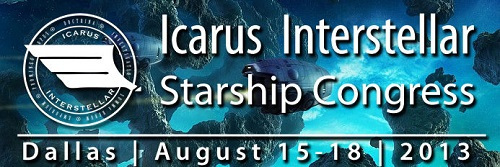





August 13, 2013
Earthbound Tests for Titan Lake Lander
As we saw last week, touching down on Europa is going to be a tricky maneuver, at least based on the surface mapping we have so far, where boulders show up all the way down to the limits of resolution. That’s why we need better imagery from the moon, a major motivation for the proposed Europa Clipper. Titan poses far fewer problems. Its thick atmosphere allowed the Huygens probe to land softly after a long, slow descent by parachute. Proposals for Titan missions have included boats to explore its lakes (Titan Mare Explorer) and airborne laboratories to soar through its skies (AVIATR: Aerial Vehicle for In-situ and Airborne Titan Reconnaissance).
The SETI Institute, working with NASA, has been testing the lake option at Laguna Negra, a lake in the Chilean Andes, in a project called Planetary Lake Lander (PLL). The idea is to develop the kind of autonomous hardware we’ll need to explore Titan from the surface. But PLL is a dual-purpose mission that also studies the watershed of Chile’s Echaurren Glacier, a freshwater source for millions that is rapidly disappearing. The expertise the researchers bring to the lake thus becomes useful not only in modeling a highly changeable environment on Titan but also in providing real-time data on the impact of deglaciation on terrestrial lake habitats and biology.
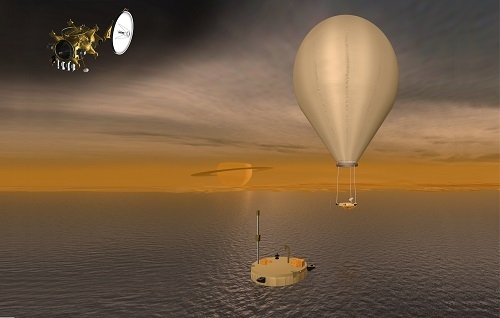
Image: The NASA Lake Lander robots lands on Titan’s lake in an artist’s imagining. Credit: NASA/JPL.
The prototype robot has been operational since 2011, charting the lake’s depth and making a variety of scientific measurements. A report from Laguna Negra by one of the team members last December describes testing the PLL on a three-kilometer sail across the lake in a journey that took eight hours, with data from the lander being sent to NASA Ames as it would be on a real mission, though via orbiting communications satellites rather than the Deep Space Network. A real mission would also cope with bandwidth restrictions not being mimicked in this work.
This National Geographic article notes that the current PLL unit is too heavy to ever make it into space, but astrobiologist Nathalie Cabrol, who leads the lander’s science team, likens the work to where the Mars rover teams were ten to fifteen years ago, when their prototypes were undergoing tests in the desert. PLL has been at Laguna Negra conducting unsupervised operations through the Chilean winter, but the researchers plan to return to work on the robot’s sensors and problem-solving capabilities, crucial in an environment where communications times run in hours in both directions. Autonomous operations are obviously an essential. “We’re not only building a robot, but a new generation of robots,” says Cabrol. “The new generation will not just be sitting around waiting for us to tell them what to do.”
A Titan lake lander would float across the surface of a large Titan lake like Kraken Mare or Ligeia Mare, measuring winds, waves and changes in the weather. Because it is the only other body in the Solar System known to have stable liquid on its surface, Titan’s lake explorations can be readily modeled on Earth. And in terms of getting down safely, it compares well with Mars, as the PLL team noted in a post last year:
The Earth’s surface is shaped by plate tectonics, so we have distinctive low ocean basins and higher terrain on the continents. Mars and Titan are single plate planets, and so have a more uniform distribution of topography. However, Mars, more like Earth, has had a lot of volcanic and tectonic activity, that has formed the tallest volcano in the solar system (Olympus Mons) as well as very deep and large canyons (Valles Marineris). Titan has a lot of erosion from its methane rainfall and little tectonic and volcanic activity, and so has very low topography. Topography is challenge of you are trying to land a rover, so the Curiosity rover had a radar to make sure the landing site was safe. That is certainly an advantage of landing on a lake on Titan- a very flat and safe surface!
From an astrobiological perspective, a Titan lake lander could tell us much about the complex chemistry on the moon. PLL lead engineer Trey Smith, discussing Titan’s hydrocarbon atmosphere and lakes, adds that interesting organic chemistry is probably happening on the surface: “No living thing we know of on Earth could survive on Titan,” he said, “but that doesn’t mean there isn’t some other exotic form of life there.” Life’s chances at -180 Celsius may be hard to calculate, but that’s one good reason to get an instrument package back to Titan, whether airborne or afloat. Whichever option we use, the views should be spectacular.






August 12, 2013
Alpha Centauri Prize Announced
As we approach Starship Congress in Dallas, the Institute for Interstellar Studies has announced the creation of the Alpha Centauri Prize Awards, the first of which will be the ‘Progenitor Award,’ to be bestowed at this year’s Starship Congress on August 18. The winner will receive a certificate and $500 cash award donated by Icarus Interstellar, the organization behind the Dallas meetings. The winner is to be chosen from among those presenting at the Starship Congress.
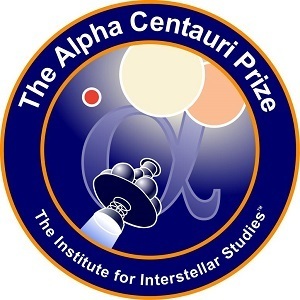
The Dallas gathering that convenes this Thursday will be the third major interstellar conference so far this year, following conclaves in Huntsville (Tennessee Valley Interstellar Workshop), San Diego (Starship Century) and preceding September’s 100 Year Starship Symposium. In addition, a conference on The Philosophy of the Starship was held by I4IS in London in May. In that suddenly quickened climate for interstellar studies the judges for the Alpha Centauri Prize Progenitor Award are being asked to make their selections based on originality, direct relevance to interstellar flight, and the potential of the work to be viable both technologically and economically in this century.
Addendum: Kelvin Long writes to tell me that another Starship Century conference will take place in London this October, along with a conference on Project Icarus. More on these when I have further information.
The Progenitor Award is the first of what is to become a series of awards in deep space design. Subsequent awards are, according to an email from I4IS executive director Kelvin Long, to be launched over the next two years. The intent is to provide incentives for design work of relevance to interstellar flight. A recent post on the Institute for Interstellar Studies website offers this:
We will set technical standards for physicists, engineers, biologists and scientists to reach for, harnessing the skills of old, and building the skills of new. We will foster and encourage pathways to new design concepts which solve old problems, and generate insights into new ones…
As explained in the I4IS post, the larger motivation is to adopt the lessons learned in the Ansari X-Prize competition to spur innovation and create technical developments in interstellar research. Here the future competitions become ambitious indeed, encompassing design studies by international teams of 6-10 designers, with each team submitting a final report to a judging panel after a development time of one year, and recurrent competitions taking place every two to three years. The plan is to drive design work in a host of projected technologies:
The Alpha Centauri Prize would be an international competition that has the function of incentivizing research, contributing technical knowledge, developing designer capability whilst inspiring the public towards the vision of interstellar flight. It is one of the best ways to advance the prospects for interstellar travel, and to have separate design studies, which could be derived, iterated and improved. Over time, the concept would be worked upon by future generations and ultimately lead to a direct design blue print for an interstellar probe after several decades of running. Like the BIS/Icarus Interstellar Project Icarus and the soon to be announced I4IS Project Dragonfly, it is the hope that other teams around the world would be assembled to work on specific proposals investigated historically such as NERVA, Starwisp, Vista, Longshot, AIMStar, Orion or one of the many others.
Long and Icarus Interstellar’s Richard Obousy created Project Icarus in 2009 as both a continuation and redefinition of the 1970s era Project Daedalus. The competition foreseen in the Alpha Centauri Prize, unlike Icarus, does not focus on a single propulsion system but considers all options from solar sails to antimatter, eschewing redesigns of historical work to create what the site describes as ‘new and innovative design concepts.’ I4IS envisions competitions taking place every two to three years to increase the technological readiness of different propulsion schemes, with eventual cash prizes in the $10,000 to $100,000 range:
After running the competition for two decades we may find that what may emerge is not a single choice for going to the stars in the coming centuries, but instead a realization that it is a combination of approaches with highly optimized engineering designs that will be the way to go. This may suggest hybrid propulsion schemes and could for example be along the lines of a fusion-based drive with anti-proton catalyzed reactions but using a nuclear electric engine for supplementary power and perhaps a solar sail and MagSail for solar system escape or upon arrival. From the two decades of research will develop reliable engineering studies, practical progress of the technology and several clear front runner designs to focus initially divergent research options towards the proper investment into the clear front runner designs by a process of gradual down select.
Competitions have proven their worth in aviation and aerospace (think Lindbergh and Burt Rutan), but in those cases we were dealing with existing or near-term technology and building hardware. What I4IS intends with the Alpha Centauri Prize is to turn the same principles to work at design studies that will surely out-run present-day engineering. It’s an idea that worked with the volunteer teams that have designed Daedalus and are now designing Project Icarus. With government funding all but non-existent on most of these concepts, it’s heartening to think that philanthropic alternatives can be found to push studies across the spectrum of propulsion options. A torrent of research papers would be a welcome outcome of such competitions.






August 9, 2013
Landing Sites on Europa
A paper just published online by the journal Astrobiology examines what a Europa lander could accomplish on the surface. It’s part of the process of future mission building even if that future is deeply uncertain — we’re a long way from a Europa lander, and funding even a far less demanding flyby mission is problematic in the current environment. But Robert Pappalardo, lead author of the study at JPL, explains the rationale for a close-up study of the icy world:
“If one day humans send a robotic lander to the surface of Europa, we need to know what to look for and what tools it should carry. There is still a lot of preparation that is needed before we could land on Europa, but studies like these will help us focus on the technologies required to get us there, and on the data needed to help us scout out possible landing locations. Europa is the most likely place in our solar system beyond Earth to have life today, and a landed mission would be the best way to search for signs of life.”
The image below, which offers a pole-to-pole view of Europa by overlaying higher resolution mosaics over a lower resolution global view obtained during Galileo flybys, shows the vivid linear features (lineae) whose color has been enhanced to highlight the red markings associated with many of them. Some of these features may well have biomarkers near them that have reached the surface from the global ocean beneath. Modeling their formation presents the possibility of fracturing caused by processes in the ice shell itself, with some models suggestive of liquids pushing through the fractures to form the numerous ridges we see on the surface. It’s precisely here that we could find exchanges of material between the surface, the icy shell and the ocean.

Image: The terrain in this view stretches from the side of Europa that always trails in its orbit at left (west), to the side that faces away from Jupiter at right (east). In addition to the lineae, the regional-scale images contain many interesting features, including lenticulae (small spots), chaos terrain, maculae (large spots), and the unusual bright band known as Agenor Linea in the south. The mosaic was constructed from individual images obtained by the Solid State Imaging (SSI) system on NASA’s Galileo spacecraft during six flybys of Europa between 1996 and 1999. Credit: NASA/JPL-Caltech/University of Arizona.
Radiation is obviously a factor near Europa, one that will have a huge impact on hardening a lander for survival but also on choosing the most likely landing site. The paper points out that many of the darkest features on the moon also seem to be the youngest and are therefore likely to be less processed by radiation. The team, whose members were drawn from a number of NASA centers and universities, made lower radiation regions a priority for choosing sites where a lander would operate.
Europa’s so-called ‘chaos’ regions — marked by jumbles of ridges, plains and cracks — are the most likely targets because of their apparently young age and their associated dark plains that may consist of frozen fluid from the ocean. The image of suggested landing sites below is drawn from the paper, with associated caption.
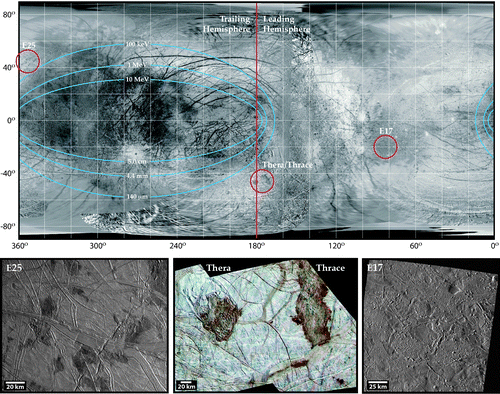
Image: Candidate landing sites on Europa. Top: Blue contours show radiation intensity on Europa’s surface, as labeled with the geographic extent to which electrons of a given energy affect the surface and how deeply they penetrate (excluding the effects of secondary particles)… Candidate landing sites are indicated by red circles on the global map and shown in regional scale images at bottom. Left: Dark plains associated with chaos in the Galileo E25 region. Center: The chaos terrains Thera and Thrace Maculae. Right: Dark chaotic terrain in the Galileo E17 regional mosaic. Each candidate site satisfies the criteria of low-albedo, youthful material that appears to have originated from the subsurface and is outside the most intense radiation regions on the satellite. Credit: Pappalardo et al. (full citation below).
Two candidates stand out: “Thera and Thrace Maculae present very attractive targets for exploration on the basis of their low albedo, relatively young age (they have disrupted the preexisting terrain), and likely endogenic origin. It has been suggested that water may exist beneath Thera Macula today.” The problem is that we don’t have a view of Europa’s surface detailed enough to make many further inferences without more data from reconnaissance missions. This is going to be one tough place to touch down on safely, as the paper makes clear:
The highest-resolution images of Europa’s surface currently available are the handful acquired by the Galileo spacecraft with resolutions that range from 6 to 12 m/pixel. These show a surface that is rough down to the pixel level, containing fractures, slopes, and scarps. Most daunting are plates and matrix material resulting from chaos formation…, although these are scientifically very attractive places to explore. Imaging with resolution of 4 m/pixel of very young and active terrain on Saturn’s satellite Enceladus—in a portion of Enceladus that resembles Europa’s surface at comparable (tens of meters) resolution—reveals a landscape with many large ice boulders down to the resolution limit.
All of which puts the focus on existing mission candidates like Europa Clipper. Planetary geologist Philip Horzempa provided a recent update on this concept, which could launch as early as 2021 depending on ever-present budgeting fluctuations. Europa Clipper would not be a lander but a Jupiter orbiter that, over the course of two and a half years, would perform 32 flybys of Europa, the closest as low as 25 kilometers. According to Horzempa, the mission is seen as a precursor to a future lander, with a reconnaissance camera included as part of the package to provide lander-scale characterization of the surface with resolutions down to 0.5 meters.
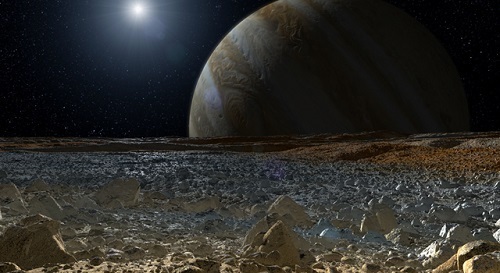
Image: This artist’s concept shows a simulated view from the surface of Jupiter’s moon Europa. Europa’s potentially rough, icy surface, tinged with reddish areas that scientists hope to learn more about, can be seen in the foreground. The giant planet Jupiter looms over the horizon. Image credit: NASA/JPL-Caltech.
A future team of Europa lander specialists would study a selection of perhaps fifteen potential landing sites to down-select to a primary and a backup. Read Horzempa’s essay for more on the instruments being designed for the mission, which will have to survive intense radiation exposure through the use of 150 kilograms of dedicated radiation shielding. The Clipper team is weighing numerous options including mini-probes (nanosats) that might orbit or even make a hard landing on Europa. As we wait to see what plays out on the funding front (and remember the ongoing cost of the James Webb Space Telescope), work on the Europa Clipper design continues even as we ponder the most effective sites for safe operations and science on the surface.
The paper is Pappalardo et al., “Science Potential from a Europa Lander,” published online by Astrobiology August 7, 2013 (full text). This presentation of the Europa Summer Study Report to the Outer Planets Assessment Group also offers helpful background.






August 8, 2013
Remembering John Billingham
Michael Michaud is no stranger to these pages, with a number of prior contributions and a reputation that precedes him in the field of SETI and interstellar research at large. Among his accomplishments are a lengthy career in the U.S. Foreign Service, where he served as Counselor for Science, Technology and Environment at U.S. embassies in Paris and Tokyo, and Director of the State Department’s Office of Advanced Technology. His involvement with SETI is lengthy and includes chairing working groups at the International Academy of Astronautics and numerous articles and papers. His book Contact with Alien Civilizations: Our Hopes and Fears about Encountering Extraterrestrials (Springer, 2007) is an indispensable contribution to the growing body of SETI literature. Today Michael reflects on the life of his friend and colleague John Billingham, who died on August 3 at the age of 83.
by Michael Michaud

One of the true pioneers of SETI has left us. John Billingham played a major role in legitimizing the once far-out idea of searching for and communicating with extraterrestrial intelligence through the technologies of radio astronomy.
Born in England, John won degrees in physiology at Oxford, as well as the equivalent of an American M.D. from Guy’s Hospital in London. He served seven years as a medical officer with the Royal Air Force, specializing in aviation medicine and physiology. A pilot, his interests then lay in flight and manned spaceflight.
Billingham came to the United States in 1963, joining NASA’s Johnson Spaceflight Center. As head of the environmental physiology office, he worked on the Mercury, Gemini, and Apollo programs, and was involved in the design of spacesuits for astronauts. In 1966 he moved to the NASA Ames research center in California, rising to chief of the biotechnology division, later chief of the extraterrestrial research division, and then chief of the life sciences division.
John was first drawn to SETI by the 1966 Shklovskii/Sagan book Intelligent Life in the Universe. He worked quietly and effectively to establish SETI as a legitimate NASA activity. Patient, polite, but determined, he gave us a model of how to move big ideas to actual programs without bluster. He eventually became Acting Chief of the office for NASA’s short-lived SETI program, cancelled in 1993.
In 1971, Billingham and Bernard Oliver organized a summer study of a system for detecting extraterrestrial technology through radio astronomy. The result was published a year later as Project Cyclops. While that system never was built, some of its concepts strongly influenced subsequent SETI programs.
John and I began exchanging correspondence in 1976, beginning a long collaboration on the social and policy aspects of SETI. As the chairman of the International Academy of Astronautics SETI Committee, he broadened SETI sessions at the annual International Astronautical Congress to include non-scientific and non-technical issues such as how we should organize ourselves for contact and what procedures we should follow after a detection.
As early as 1981, John was raising the questions of whether we should reply, what we should say, and who decides. Discussions at the 1987 Congress led to the drafting of the Declaration of Principles Concerning Activities Following the Detection of Extraterrestrial Intelligence (better known as the First SETI Protocol), published in 1989. John was instrumental in organizing workshops on the cultural and social aspects of contact, leading to the publication of Social Implications of the Detection of an Extraterrestrial Civilization in 1994.

Image: SETI investigator John Billingham, whose recent death deprives the field of one of its most supple minds. Credit: SETI League.
After retiring from NASA, Billingham became Senior Scientist at the SETI Institute. He was invited to join the Board of that organization, where his title was Trustee Emeritus.
During the 1990s, Billingham and a few of his allies developed a White Paper on communication with ETI, including principles for a second protocol on transmissions from Earth. This document was presented to the United Nations Committee on the Peaceful Uses of Outer Space in 2000. Three years later, the new chairman of the Academy’s SETI Study Group began an effort to improve the first SETI Protocol and to formalize the second. Differences over how to address transmissions from Earth intended to attract the attention of other technological civilizations proved unbridgeable. John and I resigned from the group in 2007.
The Active SETI issue remains unresolved. Billingham had commented long before that SETI tugs at beliefs and provokes polarization.
For a time, the California license plate on John’s car read SIR SETI, a token of appreciation from his colleagues. He still is SIR SETI to me.






August 7, 2013
‘Graveyard Comets’ in the Asteroid Belt
When we study extrasolar planetary systems, we’re seeing stars and planets in a wide variety of ages and configurations, helpful in making sense out of our own system’s past. New work out of the University of Antioquia (Medellin, Colombia) suggests changes to the main belt of asteroids between Mars and Jupiter of a kind that we may one day be able to spot in the disks around stars younger than the Sun. What Ignacio Ferrin and team have found is that the main belt, already known to house more than a million objects from one meter to 950 kilometers in size, is also what their paper calls “an enormous graveyard of ancient dormant and extinct rocky comets.”
That conclusion emerges from a study of main belt asteroids recently discovered to have cometary characteristics (the paper calls these ‘asteroidal belt comets’, or ABCs). These objects sublimate ices and otherwise behave like comets even though their orbits are entirely asteroidal. The researchers believe that what we are seeing is not rocky asteroids but dormant comets whose remaining ices are hidden deep within the nucleus. Their recent activity is accounted for by slight changes in temperature whose causal agent is disruption by the gravity of Jupiter, which changes the shape of their orbits to bring them slightly closer to the Sun. Says Ferrin:
“These objects are the ‘Lazarus comets’, returning to life after being dormant for thousands or even millions of years. Potentially any one of the many thousands of their quiet neighbours could do the same thing.”

Image: These illustrations show the asteroid belt in the present day and in the early Solar System, located between the Sun (at center) and four terrestrial planets (near the Sun) and Jupiter (at bottom left). The top image shows the conventional model for the asteroid belt; largely composed of rocky material. The middle image shows the proposed model, with a small number of active comets and a dormant cometary population. The lower diagram shows how the asteroid belt might have looked in the early Solar System, with vigorous cometary activity. Credit: Ignacio Ferrin / University of Antioquia.
A decrease in perihelion distance brings changes in the amount of received energy. A truly extinct comet is one in which all the ices have already sublimated, which can happen to comets with radii in the range of 50 to 150 meters. But a larger nucleus can withstand sublimation up to a certain depth and then become dormant until it encounters an additional source of energy. Orbital changes can account for the difference. From the paper:
If the perihelion distance increases, the thermal wave would penetrate less, would not reach to the deep layer of ices, and the comet would become more dormant. On the other hand, if the perihelion distance were to decrease, the thermal wave would be more intense and would penetrate deeper reaching to the ice layer, thus awakening and rejuvenating the comet. A new round of activity would ensue. Perihelion distances of comets change randomly due to planetary perturbations especially at resonances. An example of this is the comet P/2008 R1 Garradd located very near the 8:3 resonance with Jupiter…
The paper argues that asteroid belt comets have had perihelion decreases in recent times, and presents evidence that most such objects resume activity at or after perihelion, a sharp contrast with normal comets that become active well before their closest approach to the Sun. The asteroid belt of the past, then, may have been littered by thousands of active comets, whose activity subsided as the objects aged. This work presents an alternative to theories that collisions in the asteroid belt or solar wind activity are the cause of ancient comets becoming active again.
The paper is Ferrin et al., “The location of Asteroidal Belt Comets (ABCs) in a comets’ evolutionary diagram: The Lazarus Comets,” in press at Monthly Notices of the Royal Astronomical Society (full text).






August 6, 2013
A Prize for ‘Black Sky Thinking’

If you can get your head around the idea that architecture can ‘grow’ by using the tools of synthetic biology and ‘smart’ chemistry, you’ll see that what goes on inside a starship may be radically different from anything we’ve imagined before. Rachel Armstrong has done outstanding research in the area of sustainable solutions for both natural and engineered environments, and works daily on design issues raised by new materials. It’s not surprising to find Dr. Armstrong involved with Project Persephone, the attempt by Icarus Interstellar to model environments aboard a long-duration starship that might spend centuries or more getting to its destination.
Image: Sustainability savant Rachel Armstrong, whose work involves ‘living architecture’ that makes it possible for buildings to be constructed with some of the attributes of biological systems. Credit: Icarus Interstellar.
When Richard Obousy reported in these pages last March about developments at Icarus, he noted the challenges posed by a ship like this:
A habitable long duration starship will need evolvable environments that not only use resources efficiently but can respond quickly to the needs of populations and bypass the current necessary time lags that are implicit in the current system – in identifying critical upgrades and then activating industrial supply and procurement chains – which are already playing catch-up by the time they are realized.
Of course, these are problems with direct relevance today where urban infrastructures in the era of the mega-city can quickly become outdated. The challenge in both cases is to come up with environmental solutions that can not only last but grow organically with our needs. That obviously takes us out of the realm of traditional architecture, or at least melds it with new disciplines. And it’s just that cross-disciplinary reach that Armstrong is reaching for through the Black Sky Thinking Prize, which will be awarded to an individual who tackles interstellar issues with the same willingness to supercede conventional ideas that Armstrong values so strongly.
In a just published article, Armstrong explains the kind of innovation the prize will honor:
While traditional modes of innovation rely on individuals to develop novel objects around which markets and customers are built, where the product is ‘pushed’ into use – the Black Sky Thinking Prize seeks a different kind of innovation, which is inspired by a pioneering vision that invites others to help its realisation. The Black Sky Thinking Prize therefore encourages ‘pull’, as well as ‘push’ innovation, to unite and motivate communities of interstellar researchers and explorers, to realise a shared goal. This approach to generating novelty is not only crucial for our exploration of the worlds beyond our own but may also help navigate the substantial challenges that we face here on earth, where established frameworks persuade us to constrain our thinking within the limits of incremental innovation which benefits a few, rather than the many.
The plan is for the Black Sky Thinking Prize to be awarded biennially at the Starship Congress organized by Icarus Interstellar, an event that debuts next week in Dallas. The competition begins in 2014 with a judging panel that Armstrong describes as “international experts, visionaries and mouldbreakers” now in the process of being appointed. Winners will present their ideas at the Starship Congress as well as receiving a monetary grant. More on this as it develops, but it’s worth noting here that the prize will favor conceptual breakthroughs that could influence the evolution of interstellar studies over near-term technologies.

Encouraging futurists with grants and an audience keeps new ideas in the mix, always a welcome development considering how hard it is for people to move past their preconceptions. It’s tricky for any worldview to imagine its successors,but people like Intel’s Brian David Johnson put a great deal of time into the effort. I think of Johnson with regard to the Black Sky Thinking Prize because the writer/engineer is tasked by Intel with looking about ten years out to imagine the kind of future the devices that are in the concept stage today will emerge into as products.
As Icarus Interstellar is doing with Black Sky, Intel has been encouraging such thinking for several years through its own Tomorrow Project, which involves working scientists as well as science fiction writers and a cross-disciplinary audience that participates in conversations about these matters worldwide. A current hot topic is how cloud computing, driven by chips that will soon shrink to sizes small enough to be installed on everything from clothing to kitchenware, will aggregate information to provide services whose shape we have yet to define.
The Tomorrow Project’s The Future – Powered by Fiction competition solicits science fiction, essays, comics and videos from people of ages 13-25 all over the world, with ten winners to receive cash prizes and have their work published online. Winners will be announced by the end of this year. As with Armstrong’s Black Sky Thinking Prize, Johnson’s goal is to develop humanized visions of a future that uses intelligent technology to produce sustainable lifestyles. I’m all for prizes like these that set a high bar and encourage broad participation, for the solutions to intractable issues can emerge disruptively and from unexpected quarters.






August 5, 2013
A Directly Imaged ‘Second Jupiter’?
On the scale of Jon Lomberg’s Galaxy Garden, discussed here on Friday, the star GJ 504 is less than an inch away, representing some 60 light years. In fact, as Jon reminds visitors to the Garden in Hawaii, almost all the stars visible to the naked eye are contained in the volume equivalent of a single leaf. When I speak about interstellar matters I always try to find comparisons that get across the scale of the galaxy, but I can’t think of a better way to experience that scale than to walk through these gorgeous grounds near Kailua-Kona.
As I think about GJ 504 and the Galaxy Garden, I’m also reminded that Kona is the source of one of my favorite coffees, yet another reason for making the trip. But yesterday afternoon I roasted some excellent El Salvador beans and I’m settling in with a brightly flavored mug as I write, just the thing to kick off the week. I begin it with GJ 504 because a team from the SEEDS project (Strategic Explorations of Exoplanets and Disks with Subaru) led by Japanese astronomer Motohide Tamura (University of Tokyo) has just pulled off an important discovery, the least massive planet yet to be directly imaged, as opposed to detection by transit or radial velocity.
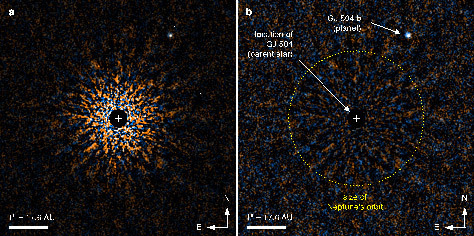
Image: Near-infrared color composite images of a “second Jupiter” around the Sun-like star GJ 504. A coronagraph and differential techniques suppress the bright light from the central star. On the left is the intensity image, which shows the radiant power passing through the area, while on the right is the signal-to-noise ratio image, which shows the weakest signal that the detecting system can recognize. Credit: NAOJ.
The star in question is a G-class object which, at 160 million years, is far younger than our Sun. In fact, the age of this system raises questions about the calculated mass of the planet. The SEEDS team comes up with a mass as small as three Jupiter masses, with the distance between star and planet being 44 AU, which would put it out around Pluto’s aphelion in our system. Is this a ‘second Jupiter,’ as this news release states? The answer depends on how accurately we can model a cooling giant planet, for the mass estimate depends upon the age of the host star and luminosity models for objects of planetary size. The paper notes that:
Because massive exoplanets cool and fade with time, direct-imaging searches have been most successful around young stars. Mass estimates for young planets depend strongly on the assumed system age, planetary atmosphere models, and initial thermodynamic state, leading to large uncertainties in the inferred mass.
GJ 504 is evidently old enough for different models – assuming different temperature ranges in early planet formation — to converge, which they do around the 100 million year mark. While the authors go on to say that “no fully established model for estimating the masses of directly imaged planets exists as of yet…,” they add that further direct imaging of older systems whose age is better determined will help us to remove many of these uncertainties.
Discovering worlds like this is going to provide ample fodder for planet formation theorists. Gravitational instability is a formation model that relies on fragmentation of the outer protoplanetary disk and subsequent collapse into a giant planet. The other model, core accretion, depends on planetesimals accumulating and acquiring a gas envelope from the protoplanetary disk. Both of these models run into problems this far out from the parent star, as both require a massive disk in the outer system. We have much to learn about the genesis of gas giants.
SEEDS is proving itself a useful window into outer planets and disk structures, with a plan to observe about 500 stars to develop statistical results on how common outer giant worlds are. But the work extends to protoplanetary disks and, because the mix of stars under investigation varies widely in age, should give us information about how both disks and planets evolve. As the project continues, we can marvel at the success of adaptive optics and coronagraphs at making observations this sensitive from Earth’s surface. It’s important work because direct imaging gives us information about a planet’s temperature, luminosity, atmosphere and orbit.
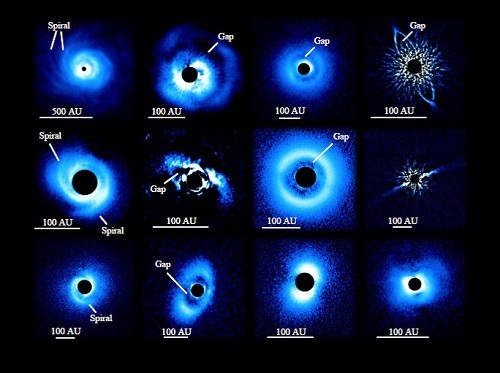
Image: Gallery of disks imaged in the near-infrared by Subaru SEEDS. Note the spirals and gaps in the disks that the images reveal. (Credit: NAOJ)
Interestingly, GJ 504b turns out to be another blue planet, an indication that its atmosphere is less cloudy than that of other directly imaged planets. Following up from the paper on this work:
…the relatively blue… color of GJ 504 b is consistent with T-type brown dwarfs in the same temperature range… which are representative of less cloudy atmospheres that could occur naturally in this temperature range… In addition, models examining cloud clearing as a function of temperature and surface gravity in Marley et al. (2012) do predict that a temperature of ∼500 K and log g of ∼4 [a measure of surface gravity], as expected for GJ 504 b… should lead to a clear atmosphere, while the properties of previously imaged planets place them in a cloudy regime. The cold and perhaps less cloudy atmosphere of GJ 504 b thus places it in a physically distinct state from the hotter and cloudier atmospheres of previously imaged planets, and should be highly interesting for further atmospheric studies in the future. These properties imply that GJ 504 b will become a benchmark object for the study of exoplanet atmospheres.
Also setting this world apart from the other directly imaged planets is its cold temperature and comparatively light mass. And while a planet three times as massive as Jupiter is a large world indeed, we can take heart from the continuing success of direct imaging campaigns as we ponder future instruments that will image smaller, Earth-class worlds.
The paper is Tamura et al., “Direct Imaging of a Cold Jovian Exoplanet in Orbit around the Sun-like Star GJ 504,” accepted for publication in The Astrophysical Journal (preprint).






August 2, 2013
The Model of the Universe
The creator of the Galaxy Garden (Kona, Hawaii), Jon Lomberg is an artist working in many media whose work continues to resonate in the space community and the public at large. Centauri Dreams readers will know him as the designer of the cover for the Voyager Interstellar Record, which is soon to become the first human artwork to leave the Solar System. But they’ll also remember COSMOS, the series for which Jon served as chief artist. In fact, he worked as Carl Sagan’s principal artistic collaborator for many years, including key work on the film CONTACT. Here Jon extends his ideas on nature, art and astronomy to venues much larger than the Galaxy Garden itself, a proposal that would model our staggeringly beautiful cosmos. For more on the concept, be aware that Jon discussed these ideas in his talk at the recent Starship Century conference, a video of which is available.
by Jon Lomberg

Astronomy daunts us with its distances. One mind-numbing number after another, equally incomprehensible. Do you have a good sense of the difference between 40 million and 140 million? Such quantities are difficult to scale and difficult to grasp.
One of the hardest concepts to convey is the scale of the Universe. Here is a proposal for a new way to address this problem.
THE MODEL OF THE UNIVERSE is a Pacific-wide system of beautiful and well-crafted markers that place extragalactic objects in an enormous scale model the size of the planet. The three dimensional model is projected onto the surface of the Earth, with the center of the Earth representing the location of the Big Bang in some higher spatial dimension. The center of the projected model is the Milky Way Galaxy Garden in Captain Cook, Hawaii. Scaled to the Galaxy Garden, a model of the Universe would be about the size of the Pacific Ocean.
Markers showing individual objects can be purchased, donated, sponsored, or built by the host business or organization. An umbrella organization and its website will provide educational materials explaining the project and providing, for example, announcements as new markers are added to the model.
The Local Group of Galaxies are scattered in the few square miles surrounding the Galaxy Garden in Honaunau. The Virgo Supercluster extends 20 miles out from the Local Group—approximately the distance between the Galaxy Garden and Kona International Airport. So all the various parks, businesses, schools, and beaches could be the site for the varied galaxies of the Virgo Supercluster.
This presents an opportunity to turn all of West Hawaii into a cosmological model of the Virgo Supercluster. The entire Big Island maps nearby superclusters. Astrotourists can spend part of their holiday exploring the extragalactic environment and getting a real sense of the relative distances to objects that are otherwise just hazily “somewhere out there.”
More distant clusters and cosmological objects are located as shown on the accompanying designs. NOTE: The mapping is preliminary only to suggest the concept.
The Galaxy Garden
If you are not familiar with the Galaxy Garden concept, please take a moment and have a look at www.galaxygarden.net.

The GG is the world’s first large-scale explorable model of the Milky Way Galaxy. Scaled at 1000 light years per foot, this 100’ garden offers visitors a direct, sensory, intuitive way to understand the scale of the solar system compared to the galaxy.
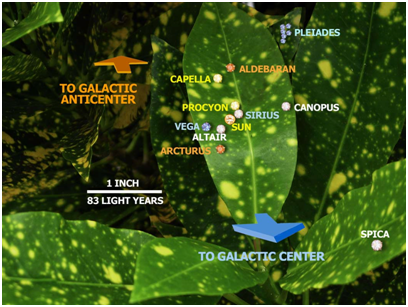
At 83 light years per inch, nearly all the stars visible to the naked eye are in a volume equivalent to a single leaf. Anyone, even a child, can understand the difference between a fraction of an inch and a 100’ garden surrounding. We have found that this conveys the scale of the Galaxy better than any other astronomy educational experience.
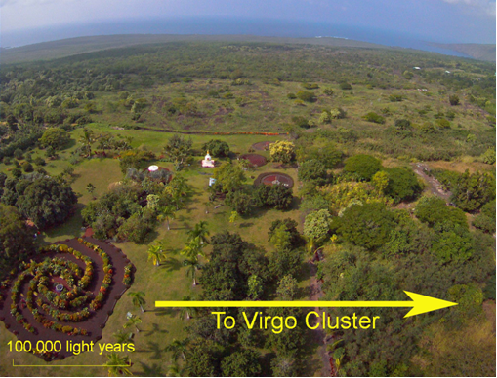
The Local Group of Galaxies are scattered in the few square kilometers surrounding the Milky Way in Honaunau.
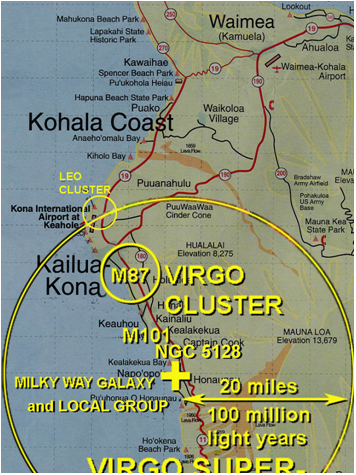
Traveling toward the town of Kailua-Kona from the Galaxy Garden, the extragalactic explorer encounters many famous galaxies, whose beautiful portraits are displayed on simple but elegant and sturdy markers. Astrotourists can spend part of their holiday exploring the extragalactic environment and getting a real sense of the relative distances to objects that are otherwise just hazily “somewhere out there.”
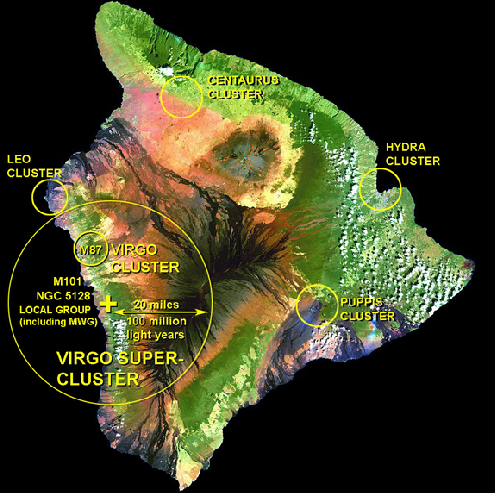
A few examples:
• NGC 5128, the brilliant radio galaxy Centaurus A, is located in Kealakekua Bay, famous historical site of Captain Cook’s visit, frequented by many tourists.
• Spiral Galaxy M101 is at the West Hawaii Community College.
• M87 is in the town of Kailua-Kona, perhaps on the grounds of the Hulihee Palace or in the lobby of the historic King Kamehameha hotel.
• The Leo Cluster of galaxies is at the Onizuka Space Center at Kona International Airport. The entire area between the Galaxy Garden and the airport is the Virgo Supercluster of galaxies.
• Other superclusters could be located in Waimea, Hilo, and Volcano.
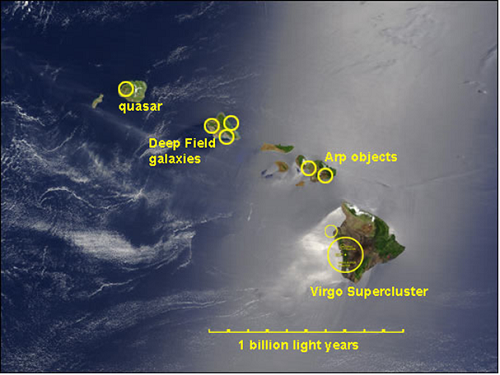
More distant objects are located on the neighbor islands, at appropriate tourist, educational, and community venues.
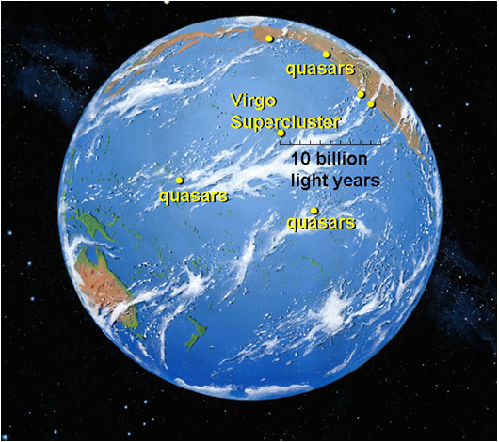
Objects at cosmological distances could be located at schools and science centers from Alaska to San Diego, as well as Tahiti (Point Venus?) and American Samoa.
Because the network projects the three-dimensional distribution of galaxies onto a spherical surface, the entire Earth becomes a model of the Universe with the center of expansion (the Big Bang) lying in a dimension not accessible from the model Universe. This provides a vivid educational metaphor that helps people to visualize the topology of the expanding universe and facilitates understanding of why there is no defined spot among the galaxies where the Big Bang took place.
Reference 1: The Virgo Supercluster
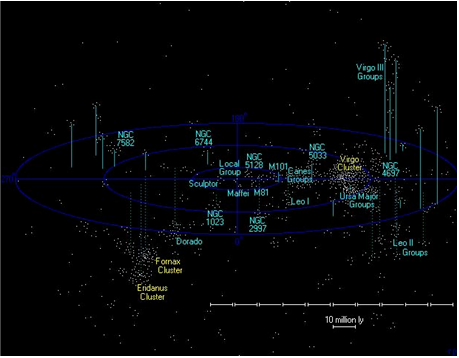
Reference 2: Other superclusters and voids out to 200 mly
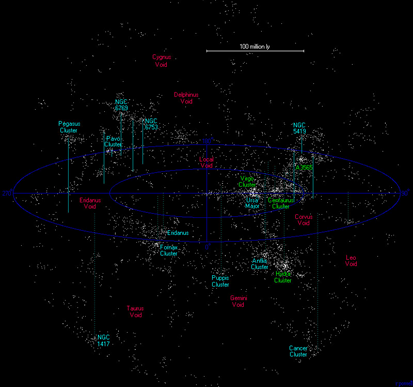
Conversion of Kona to Cosmic Distances
1” = 83 light years
1 foot = 1000 light years
100’ = 100,000 light years
1000’ = 1 million light years
10,000’ = 10 million light years = ~ 2 miles
20 miles = 100 million light years
200 miles = 1 billion light years
2000 miles = 10 billion light years
3000 miles = 15 billion light years = ~ diameter of Universe






August 1, 2013
Variability of Enceladus’ Plume
I’ve come to believe that building the system-wide infrastructure we’ll eventually need for interstellar flight will depend on satisfying two imperatives: Planetary defense and astrobiology. The first demands the ability to move payloads quickly to distant targets, allowing plenty of time to change the trajectory of problematic objects. The second is all about science and answering key questions about our place in the cosmos. I know few people who think life doesn’t exist elsewhere, but if it really is out there, finding and cataloguing it will involve human crews operating deep in the Solar System.
After all, we’re learning how widespread internal oceans may be, and it’s possible that even places as remote as Triton may have spawned some kind of organisms. And while we’ve had our eye on Europa’s hidden ocean for some time now, Enceladus is a recent entrant into the astrobiology sweepstakes with its jets of water ice and organic particles emmanating from the so-called ‘tiger stripes’ at the south pole. The Cassini orbiter discovered the jets back in 2005, and we’ve been learning more ever since. Now Cassini’s VIMS instrument (Visual and Infared Mapping Spectrometer) has given us data showing that the plumes vary predictably over time.
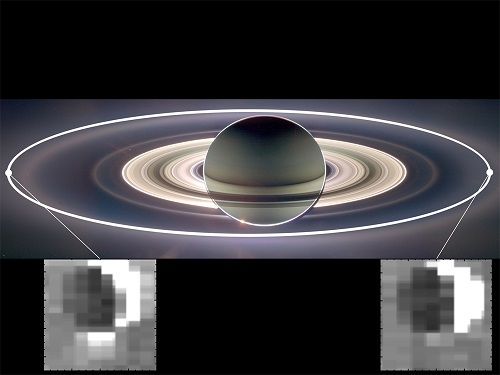
Image: Effects of the gravitational pull of Saturn on the amount of spray coming from jets at the active moon Enceladus. Enceladus has the most spray when it is farthest away from Saturn in its orbit (inset image on the left) and the least spray when it is closest to Saturn (inset image on the right). This analysis is the first clear finding that shows the jets at Enceladus vary in a predictable manner. The background image is a mosaic made from data obtained by Cassini’s imaging science subsystem in 2006. The inset image on the left was obtained on Oct. 1, 2011. The inset image on the right was obtained on Jan. 30, 2011. Credit: NASA/JPL-Caltech/University of Arizona/Cornell/SSI.
Cornell University’s Matt Hedman likens what’s happening to adjustable garden hose nozzles. As Enceladus orbits Saturn, the ‘nozzles’ in the south pole fissures close when the moon is closest to the planet, and open again as it swings further away. Think of Enceladus being alternately squeezed and released. The new findings confirm a variability in the plumes that had been long suspected but never observed until now, one that has implications for the moon’s internal structure. Says Christophe Sotin (JPL), a co-author of the paper on this work:
“The way the jets react so responsively to changing stresses on Enceladus suggests they have their origins in a large body of liquid water. Liquid water was key to the development of life on Earth, so these discoveries whet the appetite to know whether life exists everywhere water is present.”
Yes, and with New Horizons bearing down on Pluto/Charon, we’re soon going to learn whether there is evidence for internal oceans in this interesting binary system. One day, we’re going to investigate Kuiper Belt objects like Makemake and Haumea, the latter especially interesting because of its ellipsoid shape and the probability this was caused by an ancient impact. We may learn much by comparing and contrasting Haumea with other Kuiper Belt objects as we find out whether radiogenic heating could keep internal oceans liquid even in these environments.
Enceladus itself continues to teach us that objects once thought quiet can be active and filled with potential. The famous jets being sprayed from Enceladus turn out, when examined in the infrared, to be dimmest when the moon is at its closest point to Saturn, while three to four times as bright at its most distant point. Gravitational effects like these are now visible, thanks to Cassini, but they remind us of the unseen internal action taking place as the giant planet squeezes and relaxes tiny Enceladus, an energy source that has shaped the moon and perhaps created conditions hospitable to life.
The paper is Hedman et al., “An observed correlation between plume activity and tidal stresses on Enceladus,” published online in Nature 31 July 2013 (abstract).






Paul Gilster's Blog
- Paul Gilster's profile
- 7 followers



